Rosalea Barker: APEC 2011 USA – San Francisco
Rosalea Barker: APEC 2011 USA – San Francisco
September 14, 2011
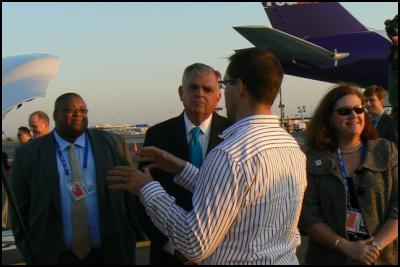
Life is full of disappointments. There I was, thinking I’d get a nice pic of Hekia Parata kicking the tyres of a potential new ministerial wagon, and instead I had to be satisfied with a photo of US Secretary of Transportation, Ray LaHood, (center) learning about what’s under the hood of a Toyota electric vehicle. Apparently, NZ’s Acting Minister of Energy and Resources didn’t have the energy to attend the exhibition of sustainable transportation options put on at Oakland’s FedEx airfield in conjunction with the APEC Senior Ministers meeting in San Francisco. But she did put out a nice press release.
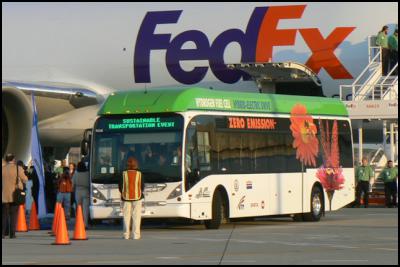
This was the first time that APEC has held a meeting of senior officials from both the transportation and energy sectors, and the local APEC 2011 USA committee has been pulling out all the stops to ensure its success. In conjunction with a number of sponsors, and with exhibitors chosen by the California Fuel Cell Partnership, the committee arranged for the press and officials to get a first-hand look at new technologies already in use and aimed at reducing carbon emissions—from electric motorcycles to hydrogen fuel-cell buses to energy-efficient cargo planes.

I was curious what a solar panel company was doing at this event, and learned that not only did Sunpower provide solar panels for the FedEx facility, but it is also teaming up with Ford to provide a symbiotic relationship between its products and Ford’s new range of electric cars. All very well to reduce your power bill by going solar, but what about that drain on your electricity when you’re charging your car overnight?
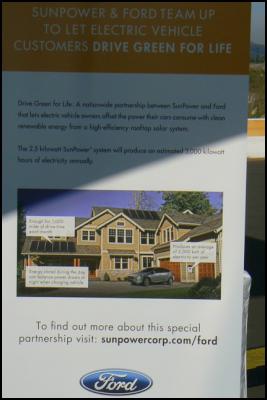
Click for big version.
Besides Ford, other auto manufacturers at the exhibition included General Motors, Honda, Mercedes-Benz, Nissan, Toyota, Chrysler, CODA Automotive, Mazda, and BMW. All of them had a vehicle and a chauffeur to take you for a test drive around a small area of the FedEx airfield. Partial to Minis, I took a spin in one of their EVs with Peter Dempster, Advanced Technology Engineer at BMW’s Technology Office USA, which is in Silicon Valley.
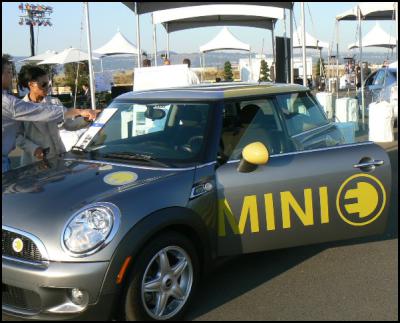
He explained to me the investment BMW is making in what it sees as a bright future for multimodal transportation, especially as it applies to those who live in large cities. It’s not just electric vehicle car-sharing or electric bikes he’s talking about, but also the smartphone apps to make a journey of many modes as smooth as possible. It seems to me to be a tectonic shift away from automotive manufacturers simply wanting to sell as many units as possible, to a new way of seeing “mobility” as a lot more than just a set of wheels and an engine. Here is my in-car interview with him, complete with sales boost-talk and whoo-hoo-ing, stumbling interviewer:
http://img.scoop.co.nz/media/audio/1109/MiniEV.WMA
To be honest, I was disappointed by the lack of a Kiwi presence at the exhibition. The Minister of Transport, Steven Joyce, sent two public servants to San Francisco in his stead—perhaps he was too busy dealing with RWC Opening night fallout. Several members of the Asian media were in the press gaggle, and two documentary makers from the East Coast who’d jumped on board were thrilled by the interviews they’d been able to get. But there was nobody from the NZ media, apart from my self. And it would have been great to see WrightSpeed exhibiting there, but I guess they weren’t invited. Wrightspeed is the developer of a “powerful, reliable and cost-effective solution for electrifying high fuel consumption vehicles”; Ian Wright is a Kiwi.
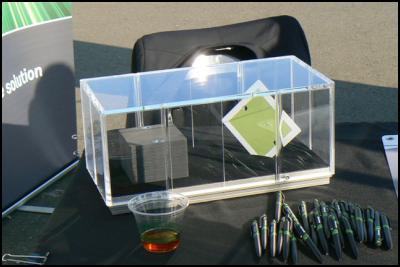
Inadequate to the task, I wasn’t able to get any definitive answers from Bloomenergy—makers of the electricity generators that power some of the FedEx facility—about where the raw materials for their proprietary solid oxide fuel cell tiles come from. But each Bloom Energy Server “provides 100kW of power enough to meet the baseload needs of 100 average homes or a small office building day and night, in roughly the footprint of a standard parking space.” Sunpower was similarly circumspect about the sources of its raw materials.
It seemed that every technology on display there had a prior cost in unsustainable energy to get to the production of sustainable energy, whether it was used for powering cars or for distributing electricity, and that’s a worrisome thing.
ENDS


 Keith Rankin: Dodgy Democracy, The Fiscal Double Standard, And The Application Of The Domino Theory To Ukraine
Keith Rankin: Dodgy Democracy, The Fiscal Double Standard, And The Application Of The Domino Theory To Ukraine Gordon Campbell: On Why GP Practices Are In Crisis
Gordon Campbell: On Why GP Practices Are In Crisis Ramzy Baroud: From Gaza To Syria - The Unyielding Reality Of Israeli Settler Colonialism
Ramzy Baroud: From Gaza To Syria - The Unyielding Reality Of Israeli Settler Colonialism Martin LeFevre - Meditations: The Polycrisis, Knowledge, And AI
Martin LeFevre - Meditations: The Polycrisis, Knowledge, And AI Ian Powell: Getting Out Of The Current Health System Mess
Ian Powell: Getting Out Of The Current Health System Mess Binoy Kampmark: More Guns, Less Butter - Starmer’s Defence Spending Splash
Binoy Kampmark: More Guns, Less Butter - Starmer’s Defence Spending Splash